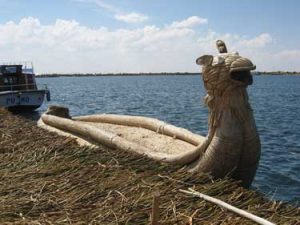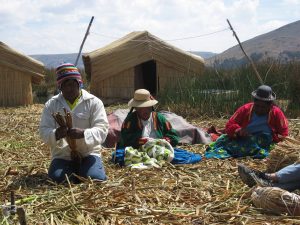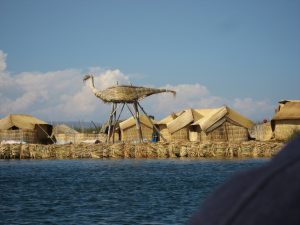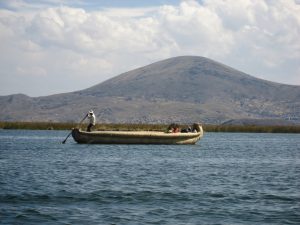Floating Islands of Uros (ADVANCED LEVEL)




- Remember, expect this to be challenging.
- First, read the English version.
- Next, read the Spanish version.
- See how many words and phrases you can pick out.
- Make sure to answer the questions to practice your reading comprehension, always using complete sentences.
The Floating Islands of Uros (advanced level)
The Uros are an indigenous group that pre-dates the Inca. Although there has been interbreeding with the mainland Aymara and they have lost their original language, they still exist today as a cultural group. To escape the persecution and enslavement by the Inca and clashes with rival tribes, they built reed islands a few kilometers off the shores of Lake Titicaca in Peru. Ironically, the mighty Inca and most of the other tribes are long gone, but the Uros remain and continue to persevere, if not thrive. Why were they successful in navigating the treacherous shoals of time when other, sometimes more powerful and advanced peoples were not? Certainly in part they owe their longevity to the totara reed.
The totara is a cattail type of rush that grows in the shallows of the lake. The floating islands are entirely comprised of totara. It grows densely enough to cut blocks which they tie together to form the very “ground” they walk on. The islands are anchored by rope tied to stakes driven into the lake bottom. Totara provides the Uros with building materials, food, medicine, and fuel. They build their houses and boats with it. The asparagus-like heart of the reed is an ingredient in most meals. This white inner part of the plant contains iodine, which prevents goiter. They also wrap the reed around an injury to help alleviate pain. The flower is brewed to make a tea. They make a platform of stones on the “ground” and use dried reeds to cook meals on the stones. Totara reed is traded for essentials such a quinoa, which is a nutritious grain. In recent years, they have used reed to fashion craft items for the tourist trade.
As part of our tour we took a ride in one of the boats to visit another island. We sat sideways with the rounded side of the boat perfectly supporting our backs and with our feet resting comfortably in a small depression that ran the length of the boat. Our guide reminded us of a gondolier as he deftly paddled us through the inter island channels while standing in the stern. The boat was perfectly balanced and the ride was smooth .
We were entranced by the beautifully constructed reed boats, the fanciful woven sculptures of huge cranes, the experience of treading on a surface that is akin to walking on a waterbed, and by the welcoming nature of the Uros. But although they have endured and adapted to the vicissitudes of life for hundreds of years, multiple threats face them today. In spite of the fact that the government created the Titicaca National Reserve in 1978, preserving 37,000 hectares of marsh reeds, the raw sewage and agricultural runoff that periodically pour into the lake from the mainland has created health problems for the Uros children, and retards the growth of the reeds, making it more labor intensive to maintain the islands. Also, overfishing by commercial operators has forced the Uros to paddle their reed boats further to catch less, adding to the strain on their daily lives.
The Uros initially resisted tourism, but gradually realized that tourism could help them survive as a culture. Tourist dollars help them earn money to procure medicines and health care for their children, who suffer from a higher infant mortality rate and lower levels of health than their mainland counterparts. The money also help pays for schooling on the mainland, for like all parents, they want their children’s life to be better than their own. Many Uros who were living on the mainland have moved back to the islands to earn income from tourist visits. In a sense, even as tourism is altering their way of life it is helping to partially preserve it. But it is not the first time the Uros have adaped to a changing enviroment. For hundreds of years they have found a way to be who they are, and give every sign they will continue to do so.
Las Islas Flotantes de Uros (nivel avanzado)
Los Uros son un grupo indígena que precede a los Incas.
Aunque se han mezclado con los Aymara y han perdido su lengua oficial, todavía existen hoy en día como un grupo cultural. Para escapar la persecución y exclavitud de los Incas y los enfrentamientos con las tribus rivales, construyeron islas de juncos a unos kilómetros de las orillas del Lago Titicaca, en Perú. Irónicamente, los poderosos Incas y la mayoría de las otras tribus, han desaparecido hace mucho, pero los Uros persisten, y continúan perseverando, y aún prosperando.
¿Por qué tuvieron éxito navegando los traicioneros bancos del tiempo cuando otras gentes, más poderosas y avanzadas no lo consiguieron? Ciertamente deben su longevidad a la caña de totara.
La totara es una especie de espadaña que crece en las orillas del lago. Las islas flotantes están totalmente compuestas de totara. Crece tan densa que se puede cortar en bloques, los cuales amarrados, pueden formar el piso para caminar sobre ellos. Las islas están ancladas con cuerdas y atadas a estacas clavadas en el fondo del lago. La totara es material de construcción para los Uros, comida, medicina y carburante. Construyen sus casas y botes con ella. El corazón del junco, de forma parecida a un espárrago, es un ingrediente en casi todas sus comidas. Esta parte blanca de la planta contiene yodo, la cual previene el bocio. También vendan el junco alrededor de una herida para aliviar el dolor. La flor se hierve para hacer té. Hacen plataformas de piedras en el piso y usan los juncos secos para cocinar comidas sobre las piedras. El junco de totara se cambia por productos esenciales como la quinoa, un grano muy nutritivo. En los años recientes han usado el junco para elaborar productos artesanales, los cuales venden al turismo.
Como parte de nuestro tour, montamos en uno de los botes para visitar otra isla. Nos sentamos de lado, con el lado redondo del bote sujetando perfectamente nuestras espaldas, y con nuestros pies cómodamente afincados en una pequeña depresión a lo largo del bote. Nuestro guía nos recordó a un gondolero que nos remaba a través de los canales inter isleños mientras permanecía derecho en la popa. El bote estaba perfectamente balanceado y fue un viaje cómodo.
Nos fascinó la belleza de los botes de juncos, las maravillosas esculturas de enormes garzas, la experiencia de ir pisando en una superficie similar a ir caminando en una cama acuática, y por supuesto, la naturaleza acogedora de los Uros.
Pero a pesar de que han sobrevivido y se han adaptado a las vicisitudes de la vida durante cientos de años, se enfrentan a múltiples amenazas hoy en día. A pesar de que le gobierno declaró el Lago Titicaca como Reserva Natural en 1978, el preservar 37.000 hectáreas de marismas de juncos, las aguas negras, y el riego periódico agrícola que baja al lago de las tierras principales, ha creado problemas de salud para los niños Uros, y el retraso del crecimiento de los juncos. Esto hace que el trabajo para mantener las islas se haya hecho más intenso. La pesca comercial ha forzado a los Uros a navegar con sus botes a distancias mayores, con menos pesca, añadiendo al estrés de sus vidas diarias.
Los Uros inicialmente resistieron al turismo, pero gradualmente se dieron cuenta que el turismo podría ayudarles a sobrevivir como cultura. Los dólares turísticos les ayudan a obtener medicinas y cuidados médicos para sus niños, los cuales sufren de una tasa de mortalidad infantil más alta y niveles más bajos de salud que los de las tierras continentales. El dinero también ayuda a pagar la educación en las tierras, ya que como todos los padres, desean una vida mejor para sus hijos. Muchos Uros que vivían en las tierras principales, se han mudado nuevamente a las islas para ganar un salario de las visitas turísticas. En un sentido, a pesar de que el turismo ha alterado su modo de vida, les está ayudando a preservarlo. Pero no es la primera vez que los Uros se han adaptado para cambiar el medio ambiente. Durante cientos de años han encontrado un modo de ser quienes son, y siguen dando señales de seguir haciéndolo.
Comprensión lectora
- ¿Cómo se denomina la tribu que se describe en este artículo?
- ¿Qué es la totara?
- Nombre algunos de los usos de la totara.
- ¿Cuál es la característica principal de los Uros?
- ¿Cómo se benefician del turismo los Uros?

